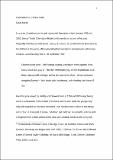Files in this item
Literature for children
Item metadata
| dc.contributor.author | Manly, Susan | |
| dc.contributor.editor | Duff, David | |
| dc.date.accessioned | 2020-10-02T23:36:29Z | |
| dc.date.available | 2020-10-02T23:36:29Z | |
| dc.date.issued | 2018-10-03 | |
| dc.identifier | 226946484 | |
| dc.identifier | 2c8bb699-59dc-48b0-9414-9692834b8f0a | |
| dc.identifier.citation | Manly , S 2018 , Literature for children . in D Duff (ed.) , The Oxford handbook of British Romanticism . Oxford University Press , Oxford . https://doi.org/10.1093/oxfordhb/9780199660896.013.14 | en |
| dc.identifier.isbn | 9780199660896 | |
| dc.identifier.isbn | 9780191756795 | |
| dc.identifier.uri | https://hdl.handle.net/10023/20719 | |
| dc.description.abstract | The child is often imagined in the work of Samuel Taylor Coleridge and William Wordsworth as a source of creative energies and of hope for the future of humanity, as well as symbolizing a return to original naturalness. But these ideas about childhood were not peculiar to the Lake poets: they have their origin in the politicized educational theories of John Locke and Jean-Jacques Rousseau, as well as in Joseph Priestley’s revolutionary rhetoric and the children’s literature that emerged from this tradition. Variously combining these influences, a new, often realist children’s literature written by Anna Barbauld, John Aikin, Mary Wollstonecraft, William Blake, Maria Edgeworth, and William Godwin sought to revolutionize the forms and content of earlier books for children. The new children’s literature of the 1790s and early 1800s envisaged a rising generation of socially engaged thinkers capable of transforming society. | |
| dc.format.extent | 333891 | |
| dc.language.iso | eng | |
| dc.publisher | Oxford University Press | |
| dc.relation.ispartof | The Oxford handbook of British Romanticism | en |
| dc.subject | Childhood | en |
| dc.subject | Nature | en |
| dc.subject | Sublime | en |
| dc.subject | Imagination | en |
| dc.subject | Politics | en |
| dc.subject | Reading | en |
| dc.subject | Liberty | en |
| dc.subject | Revolution | en |
| dc.subject | Education | en |
| dc.subject | Secularism | en |
| dc.subject | Family | en |
| dc.subject | PQ Romance literatures | en |
| dc.subject | BDC | en |
| dc.subject | R2C | en |
| dc.subject.lcc | PQ | en |
| dc.title | Literature for children | en |
| dc.type | Book item | en |
| dc.contributor.institution | University of St Andrews. School of English | en |
| dc.identifier.doi | 10.1093/oxfordhb/9780199660896.013.14 | |
| dc.date.embargoedUntil | 2020-10-03 | |
| dc.identifier.url | https://global.oup.com/academic/product/the-oxford-handbook-of-british-romanticism-9780199660896 | en |
This item appears in the following Collection(s)
Items in the St Andrews Research Repository are protected by copyright, with all rights reserved, unless otherwise indicated.

